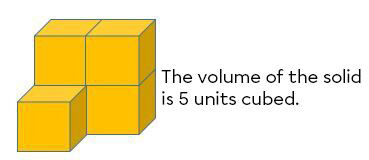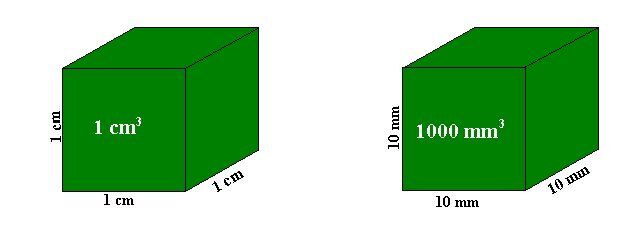Volume represents the space occupied by a solid. The volume of a solid is expressed in cubic units.

Calculating volume determines the amount of space occupied by an object. Volume is usually measured for solids, but it is also possible to use it for a liquid. In this case, it is called capacity.
The basic unit of measurement for volume in the International System of Units is the cubic metre (m3).
Here is a table of the most commonly used units to measure volume:
|
Prefix |
kilo- |
hecto- |
deca- |
|
deci- |
centi- |
milli- |
|---|---|---|---|---|---|---|---|
|
Volume |
cubic kilometre |(\text{km}^3)| |
cubic hectometre |(\text{hm}^3)| |
cubic decametre |(\text{dam}^3)| |
cubic metre |(\text{m}^3)| |
cubic decimetre |
cubic centimetre |(\text{cm}^3)| |
cubic millimetre |(\text{mm}^3)| |
|
Equivalent value in cubic metres |
|0{.}000\, 000\, 001| |
|0{.}000\, 001| |
|0{.}001| |
|1| |
|1\ 000| |
|1\ 000\ 000| |
|1\ 000\ 000\ 000| |
In this table, each unit is 1 000 times larger than the unit that follows it. Thus, 1 cubic metre is 1 000 cubic decimetres, 1 cubic decimetre is 1 000 cubic centimetres, etc.
Converting from one unit of measurement to another when measuring volume requires multiplying or dividing by 1 000.
Unlike length measurements, volume units differ by a factor of 1000.
For example, two cubes have side measurements of 1 cm and 10 mm respectively. Therefore, the two cubes have the same dimensions, but they are expressed using different units.

-
The volume of the first cube is: 1 cm × 1 cm × 1 cm = 1 cm3
-
The volume of the second cube is: 10 mm × 10 mm × 10 mm = 1 000 mm3
Note: 1 cm = 10 mm, but 1 cm3 = 1 000 mm3.
The “jump” method or a metric conversion table can be used to convert from one unit of measurement to another.
According to this method, it is necessary to:
-
Multiply by 1 000 for each “jump” (with each unit change) when going from a larger unit to a smaller unit;
-
Divide by 1 000 for each “jump” (with every unit change) when going from a smaller unit to a larger unit.

We want to convert 14.58 m3 to cm3.
To go from m3 to cm3, multiply by 1 000 for each “jump” or unit change.

|14{.}58\ \text{m}^3\times1\ 000=14\ 580\ \text{dm}^3|
|14\ 580\ \text{dm}^3\times1\ 000=14\ 580\ 000\ \text{cm}^3|
or
|14{.}58\ \text{m}^3\times1\ 000\times1\ 000=14\ 580\ 000\ \text{cm}^3|
Answer: |14{.}58\ \text{m}^3 = 14\ 580\ 000\ \text{cm}^3|
According to this method, it is necessary to:
-
Place the ones, tens, and hundreds digits of the number in the position of the given unit of measurement. Place the other numbers (if there are any) to the left of it, always in groups of three;
-
Put three 0's in each column up to the column of the new unit of measurement.
We must always put three digits in each box before changing columns.
We want to convert 234 m3 to cm3.
-
Place the 2 (hundreds), 3 (tens), and 4 (ones) in the m3 column, since it is the starting unit of measurement.
-
Put three 0's in each column up to the cm3 column, since the goal is to convert to cm3.

234 m3 = 234 000 000 cm3
When converting from a smaller unit of measurement to a larger unit, place a decimal point in the column of the desired unit of measurement.
We want to convert 7 569 800 mm3 to m3.
-
Place the 8 (hundreds), the 0 (tens), and the 0 (ones) in the column of mm3 (since the starting number is expressed in mm3).
-
The other numbers are placed in groups of three, moving left, then adding the 0s necessary to get the desired unit of measurement (m3 in this case).

-
Add a decimal point in the m3 column.

The result is 0.007 569 800 m3 or 0.007 569 8 m3.
It is possible to convert units of volume into units of capacity, but first, remember some important relationships.
|1\ \text{m}^3 = 1\ \text{kL}|
|1\ \text{dm}^3 = 1\ \text{L}|
|1\ \text{cm}^3 = 1\ \text{mL}|
We want to convert 125 hm3 into hL.
-
Convert hL into one of the three known units (see the previous section): m3, dm3, or cm3.
125 hm3 × 1 000 = 125 000 dam3
125 000 dam3 × 1 000 = 125 000 000 m3 -
Convert the m3 into kL.
Since 1 m3 = 1 kL, the result is:125 000 000 m3 = 125 000 000 kL
-
Convert the kL into hL:
125 000 000 kL × 10 = 1 250 000 000 hL or 1.25 × 109 hL